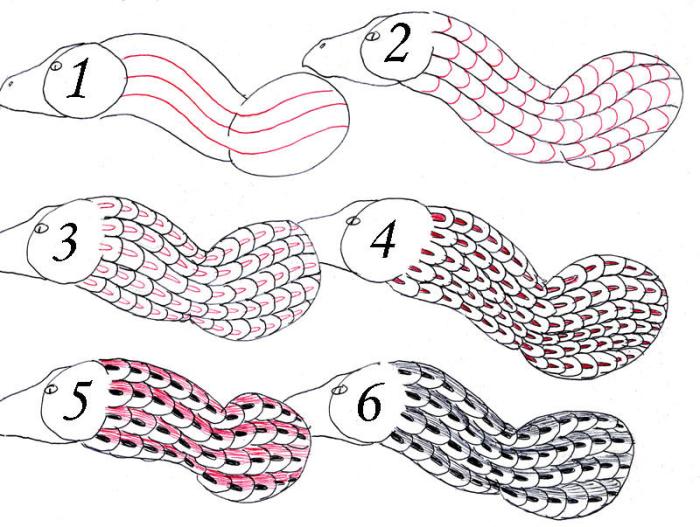How to draw dragon scales – Dive into the art of drawing dragon scales and unlock the secrets of creating realistic and visually stunning textures. Whether you’re an aspiring artist or a seasoned pro, this comprehensive guide will empower you with the techniques and knowledge to bring your dragon creations to life.
From basic shapes to advanced shading methods, we’ll explore every aspect of drawing dragon scales. Get ready to embark on a journey of artistic exploration and elevate your artwork to new heights.
How to Draw Dragon Scales

Drawing dragon scales is a skill that can elevate your artwork to the next level. Whether you’re creating a majestic fantasy dragon or a scaled creature from another realm, mastering the techniques for drawing dragon scales will add depth, texture, and realism to your creations.
Materials and Tools

The choice of materials and tools can significantly impact the outcome of your dragon scale drawings. Here are some essential items to consider:
- Pencils:Pencils come in various grades, from soft to hard. Softer pencils (e.g., 2B or 4B) are ideal for creating smooth, blended scales, while harder pencils (e.g., H or 2H) are better for outlining and creating sharp details.
- Pens:Pens offer a more precise and permanent line than pencils. Fine-tipped pens (e.g., technical pens or micron pens) are suitable for drawing small, intricate scales, while brush pens can create thicker, expressive strokes.
- Markers:Markers are available in a wide range of colors and tip sizes. They are ideal for creating bold, vibrant scales, but their quick-drying nature requires a steady hand.
- Brushes:Brushes can be used with paint or ink to create a variety of scale textures. Soft brushes are excellent for blending and creating smooth transitions, while stiffer brushes can create more defined, textured scales.
Basic Techniques

Mastering the basic techniques is crucial for drawing convincing dragon scales. Here’s a step-by-step guide to get you started:
- Draw the Base Shape:Start by sketching the basic shape of the scale, whether it’s round, oval, or triangular.
- Add Shading:Using a pencil or pen, shade the scale to create a sense of depth. Apply darker shades towards the edges and lighter shades towards the center.
- Highlight:Add highlights to the scale to create a three-dimensional effect. Focus the highlights on areas that would naturally catch the light.
Advanced Techniques
Once you’ve mastered the basics, you can explore advanced techniques to create more realistic and intricate dragon scales:
- Create Patterns:Add patterns to your scales using dots, lines, or other geometric shapes. These patterns can enhance the texture and visual interest of the scales.
- Use Layering:Layer multiple scales on top of each other to create a sense of depth and realism. Overlapping scales can create interesting shadows and highlights.
- Blend and Smooth:Use a blending stump or tortillon to smooth transitions between scales and create a seamless, cohesive look.
- Study Reference Materials:Observe real-life reptiles, such as snakes or lizards, to study the natural patterns and textures of their scales. This can help you create more accurate and realistic dragon scales.
Composition and Arrangement

The arrangement of your dragon scales plays a crucial role in creating a visually appealing composition:
- Scale Size and Shape:Vary the size and shape of your scales to create a sense of movement and depth. Smaller scales can suggest distance, while larger scales can emphasize foreground elements.
- Color and Texture:Use color and texture to differentiate between different types of dragon scales. Metallic scales, for example, can have a shiny, reflective texture, while earthy scales can have a rough, matte texture.
- Negative Space:Pay attention to the negative space around your scales. Negative space can help create a sense of balance and depth in your composition.
Color and Shading, How to draw dragon scales
Color and shading are essential elements for creating realistic and visually striking dragon scales:
- Color Theory:Understand the principles of color theory to create visually appealing color combinations. Complementary colors, for example, can create a sense of contrast and excitement.
- Shading for Volume:Use shading to create a sense of volume and realism in your dragon scales. Apply darker shades in areas where the scales would naturally be in shadow, and lighter shades in areas where they would catch the light.
- Color Variation:Introduce color variations within your scales to create a more dynamic and visually interesting look. This can include subtle shifts in hue, saturation, or value.
Inspiration and References
Seeking inspiration and studying references can help you create stunning dragon scale artwork:
- Online Galleries:Explore online galleries and websites dedicated to dragon art and illustrations. This can provide a wealth of inspiration and ideas.
- Books and Tutorials:Read books and follow tutorials specifically focused on drawing dragon scales. These resources can offer valuable insights and techniques.
- Observe Nature:Study the scales of real-life reptiles, such as snakes, lizards, and crocodiles. Observing their patterns, textures, and colors can provide valuable inspiration for your dragon scale drawings.
Essential Questionnaire
What materials are essential for drawing dragon scales?
Pencils, pens, markers, and brushes are all suitable tools for creating dragon scales, each offering unique advantages and effects.
How can I create depth and texture in my dragon scales?
Use shading and highlighting techniques to add depth to your scales. Experiment with different angles and intensities of light to achieve a realistic look.
What techniques can I use to draw intricate patterns on my dragon scales?
Layering and blending are effective techniques for creating intricate patterns on dragon scales. Start with a base layer and gradually add additional layers, blending them together to create smooth transitions.
